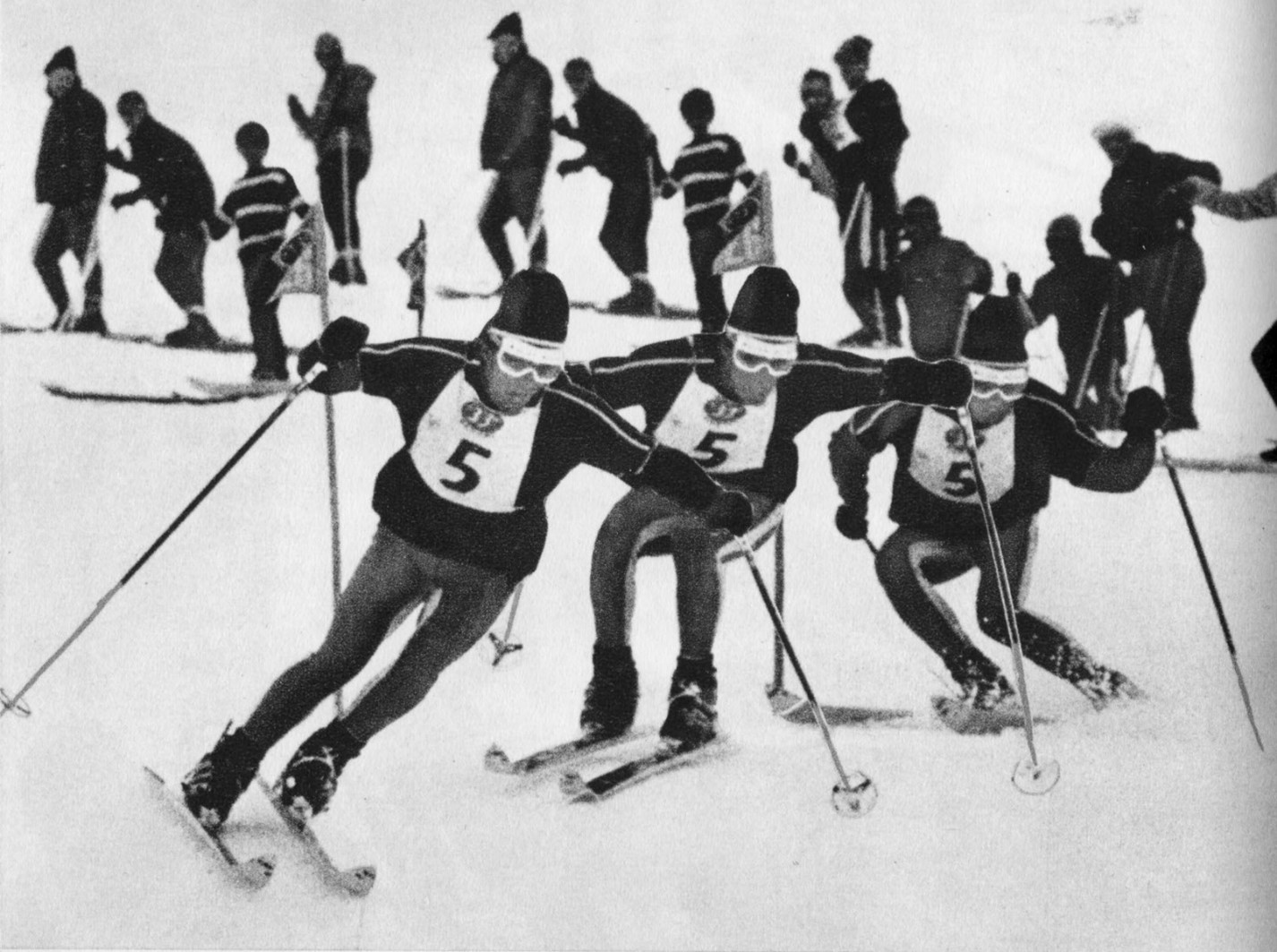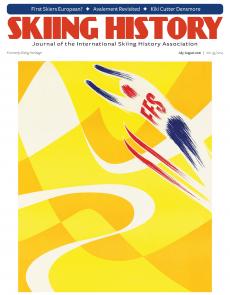SKIING HISTORY
Editor Seth Masia
Managing Editor Greg Ditrinco
Consulting Editor Cindy Hirschfeld
Art Director Edna Baker
Editorial Board
Seth Masia, Chairman
John Allen, Andy Bigford, John Caldwell, Jeremy Davis, Kirby Gilbert, Paul Hooge, Jeff Leich, Ron LeMaster, Bob Soden, Ingrid Wicken
Founding Editors
Morten Lund, Glenn Parkinson
To preserve skiing history and to increase awareness of the sport’s heritage
ISHA Founder
Mason Beekley, 1927–2001
ISHA Board of Directors
Rick Moulton, Chairman
Seth Masia, President
Wini Jones, Vice President
Jeff Blumenfeld, Vice President
John McMurtry, Vice President
Bob Soden (Canada), Treasurer
Einar Sunde, Secretary
Richard Allen, Skip Beitzel, Michael Calderone, Dick Cutler, Ken Hugessen (Canada), David Ingemie, Joe Jay Jalbert, Henri Rivers, Charles Sanders, Christof Thöny (Austria), Ivan Wagner (Switzerland)
Presidential Circle
Christin Cooper, Billy Kidd, Jean-Claude Killy, Bode Miller, Doug Pfeiffer, Penny Pitou, Nancy Greene Raine
Membership Services
Laurie Glover
(802) 375-1105
laurie@skiinghistory.org
Corporate Sponsorships
Peter Kirkpatrick
(541) 944-3095
peterk10950@gmail.com
Bimonthly journal and official publication of the International Skiing History Association (ISHA)
Partners: U.S. Ski and Snowboard Hall of Fame | Canadian Ski Museum and Hall of Fame
Alf Engen Ski Museum | North American Snowsports Journalists Association | Swiss Academic Ski Club
Skiing History (USPS No. 16-201, ISSN: 23293659) is published bimonthly by the International Skiing History Association, P.O. Box 1064, Manchester Center, VT 05255.
Periodicals postage paid at Manchester Center, VT and at additional mailing offices. Postmaster: Send address changes to ISHA, P.O. Box 1064, Manchester Center, VT 05255
ISHA is a 501(c)(3) public charity. EIN: 06-1347398
Written permission from the editor is required to reproduce, in any manner, the contents of Skiing History, either in full or in part.
Avalement
Whatever Happened to Avalement? "Swallowing" remains relevant today. Early photos made it look like back-seat driving.
Photo above: This photo montage from Georges Joubert and Jean Vuarnet’s 1966 Comment se perfectionner à ski, published in the U.S. as How to Ski the New French Way in 1967, shows Jean-Claude Killy performing avalement: deeply flexing in the transition between turns with a forward movement of the feet.
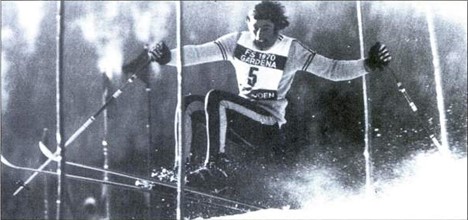
For many, simply hearing a faux francophone utter the word “avalement” conjures images of skiing’s French new wave of the early 1970s: Patrick Russell winning the FIS Championship slalom in Val Gardena. American hotdog skiers sitting waayyyyy back, supported by Jet Stix. And serious skiers everywhere coming to grips with a low, feet-apart stance often derided as “the outhouse crouch.”
I can’t think of another element of advanced ski technique that was so widely misrepresented, which misrepresentation led so many astray, yet was so important and continues to be so.
Avalement was a natural response to advances in ski design in the 1960s. When skis were made primarily of wood, and the only metal in them was their segmented steel edges, ski designers were faced with a tradeoff between making skis that were soft enough to be bent into reverse camber, yet strong enough to not break. Stein
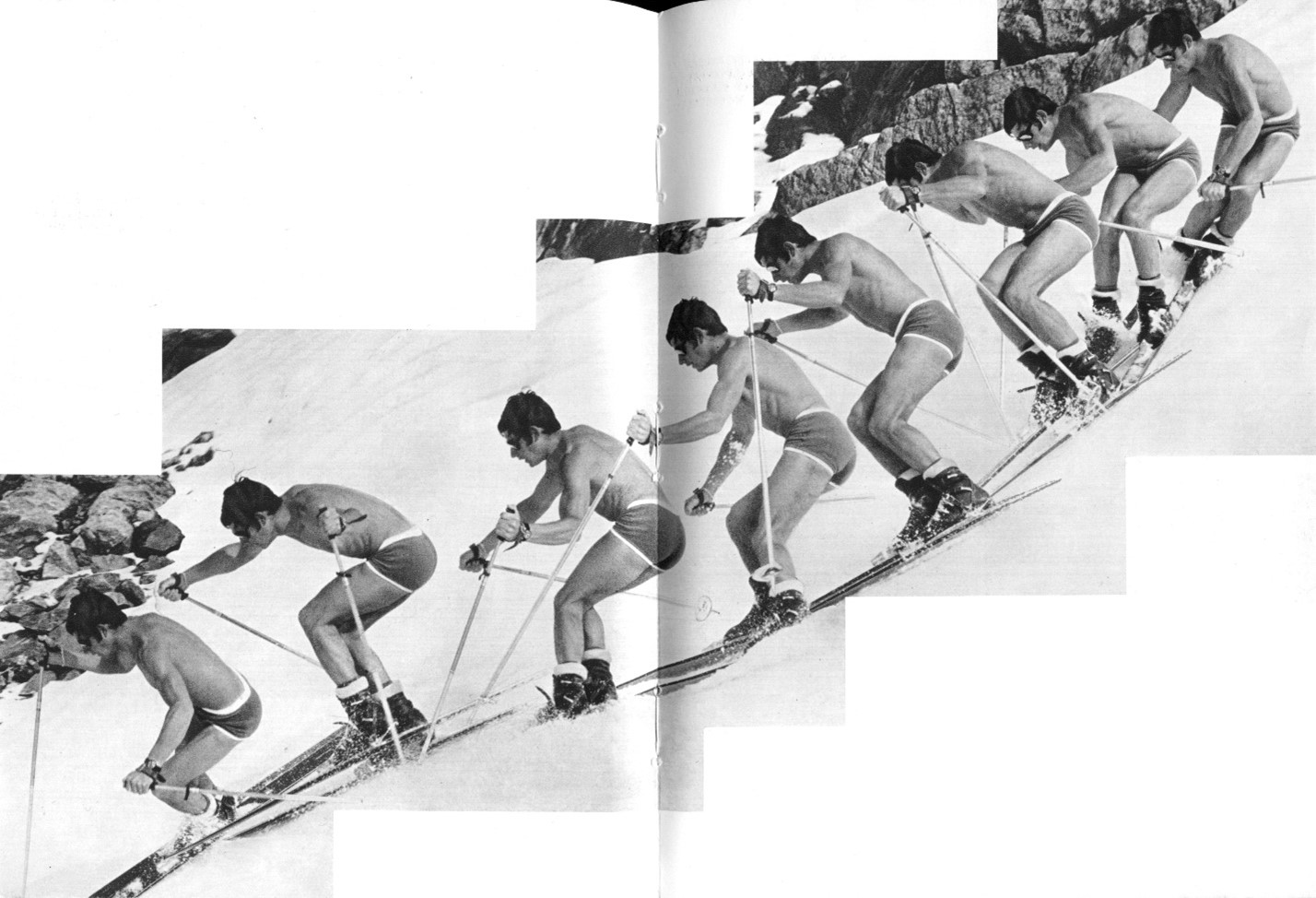
Eriksen, for one, was known to be partial to softer skis because he could make a sharper, faster turn with them. On the flip side, he was also known for breaking more skis than others. As the sole structural material, wood also made it hard to produce a ski that, while flexible along its length, remained stiff in torsion, a design parameter tied to gripping on hard snow.
By using metal and fiberglass structural sheets to control the bending properties, engineers made skis that could flex more easily without breaking, and whose stiffness lengthwise and torsionally could be controlled more independently. Box-construction fiberglass skis, such as the Dynamic VR7, were particularly good in the latter regard.
Enter Jean-Claude Killy, thought by many to be the most technically innovative skier of our time. Killy understood better than anyone else—whether intuitively or cognitively—that the new skis could in many situations turn themselves by carving rather than being steered by the skier, and in a way that was more effective and

Flynn uses carbon-copy technique
in 2021. Ron LeMaster photo.
efficient. This led to some significant things happening in the turn: The skier didn’t need to apply as much pressure in the last part of the turn to make the ski bend, or angulate as much to make it hold. This allowed Killy to reduce and often eliminate the edge set that others made at the end of the turn. The ski could also be made to bend earlier in the turn, where there was less available pressure. So avoiding protracted unweighting going into the turn became desirable. Getting the skis engaged, bent, and drawing turning force from the snow earlier in the turn required that the skier be inclined earlier too, so as to be balanced against that force.
In short, making turns on smooth, packed snow became much like skiing in moguls. And what are the most distinguishing technical characteristics of mogul skiing?
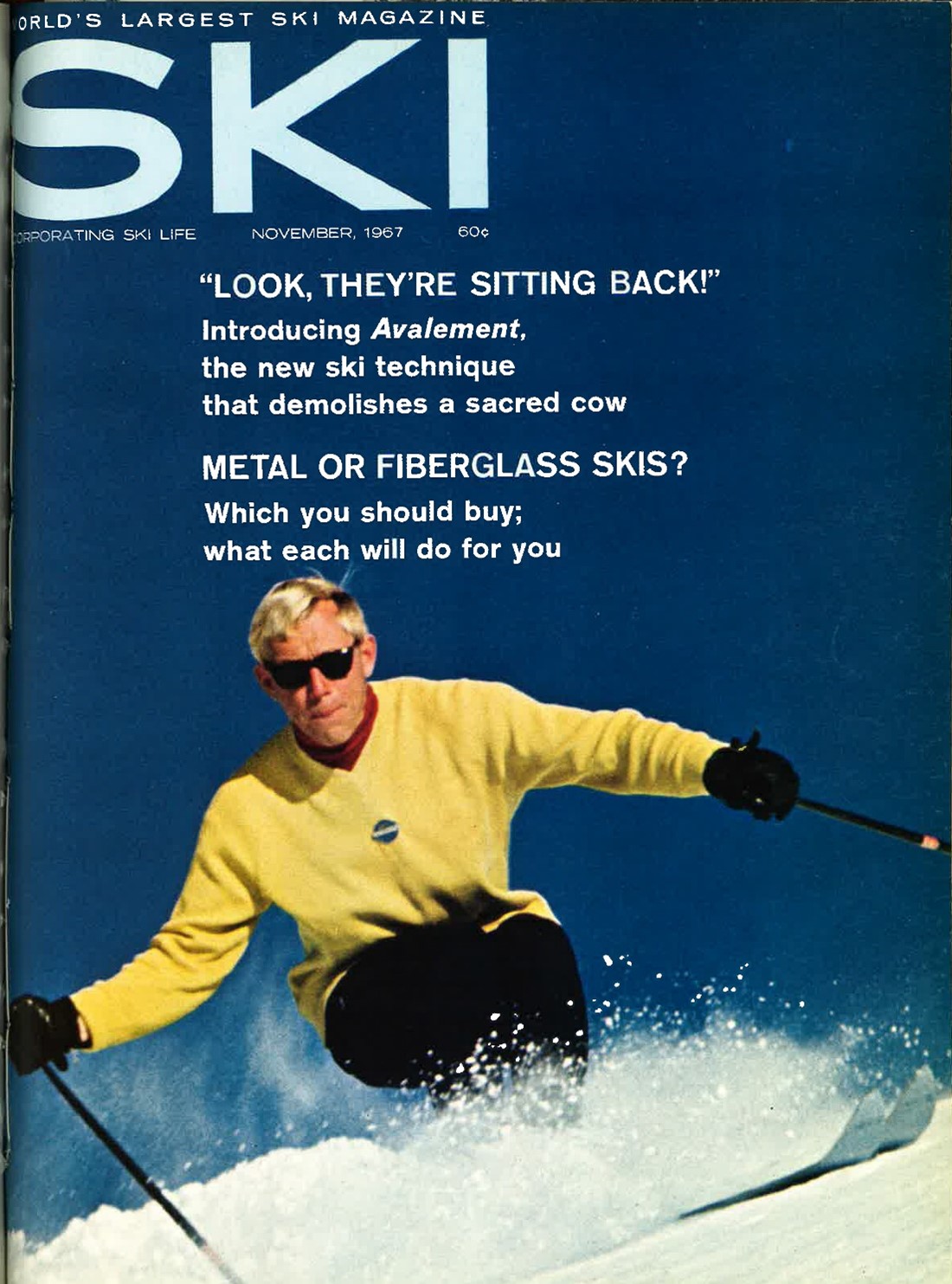
knew how to grab the public’s
attention when he alerted them
to the new wave.
Flexing at the end of the turn to absorb the force of the bump. Sliding your feet forward as you ski into the bump to prevent being pitched forward. Then extending once you’ve passed over the bump to keep your skis in contact with the snow for speed and direction control, and so you’re prepared to absorb the next bump.
Georges Joubert observed Killy’s movement of absorption and dubbed it “avalement.” Literally, “swallowing.” Dick Barrymore’s great documentary of the 1966 FIS World Championships, in Portillo, Chile, contains telling footage of Killy, Karl Schranz, Guy Périllat and others in the slalom. The difference between Killy and the rest is immediately evident. Just as striking is footage of Killy and Périllat training slalom on a rutted course. Where Périllat struggles to stay in the course, getting jolted by the ruts and leaving the snow going into every turn, Killy is unflappable.
In November 1967, SKI Magazine ran a cover story introducing avalement with the unfortunate headline “Look! They’re Sitting Back!” The article, written by Joubert and Jean Vuarnet, was far more nuanced than its title suggested. It was part of a series of articles that John Fry, SKI’s editor, ran to introduce America to Joubert and Vuarnet’s new book, How to Ski the New French Way. There was a wealth of worthwhile information in what was being published, but the skiing public was ready for a revolution and struck at the flashiest piece of bait: avalement.
The press recognized avalement’s appeal and played to it. Unfortunately, they often illustrated it with easily misconstrued photos of great skiers at extraordinary moments. As a result, legions of would-be avant-garde skiers were sent down a dead-end rabbit hole.

Did avalement die with the rise of extreme skiing or the advent of shaped skis? Hardly. The constant evolution of skis and ski boots, coupled with snow making and grooming, has enabled skiers to generate, to ever greater degrees, the very dynamics that gave rise to avalement in the 1960s. (Unfortunately, those same dynamics have been partly responsible for the rise in knee injuries.) We haven’t changed our technique, just our nomenclature. Cheapened by the misuse of the term in the ’70s and the ski community’s constant pursuit of novelty, “avalement” all but disappeared from our lexicon in the 1980s. Current fashion refers to the technique as “retraction.” Maybe in a few years we’ll call it “swallowing.” 
Regular contributor Ron LeMaster wrote about “The Comma Position” in the last issue of Skiing History (May-June 2021).
Table of Contents

Corporate Sponsors
ISHA deeply appreciates your generous support!
WORLD CHAMPIONSHIP ($3,000 AND UP)
Gorsuch
Polartec
Warren and Laurie Miller
CHAMPIONSHIP ($2,000)
Fairbank Group: Bromley, Cranmore, Jiminy Peak
Hickory & Tweed Ski Shop
Rossignol
Snowsports Merchandising Corp.
WORLD CUP ($1,000)
Aspen Skiing Company
Berkshire East Mountain Resort/Catamount Mountain Resort
Bogner
Boyne Resorts
Dale of Norway
Darn Tough Vermont
Dynastar | Lange | Look
Gordini USA Inc. | Kombi LTD
HEAD Wintersports
Intuition Sports, Inc.
Mammoth Mountain
Marker-Volkl USA
National Ski Areas Association
Outdoor Retailer
Ski Area Management
Ski Country Sports
Sport Obermeyer
Sports Specialists, Ltd.
Sun Valley Resort
Vintage Ski World
World Cup Supply
GOLD ($700)
Larson's Ski & Sport
Race Place | BEAST Tuning Tools
The Ski Company (Rochester, NY)
Thule
SILVER ($500)
Alta Ski Area
Boden Architecture PLLC
Dalbello Sports
Deer Valley
Ecosign Mountain Resort Planners
Fera International
Holiday Valley
Hotronic USA, Inc. | Wintersteiger
MasterFit Enterprises
McWhorter Driscoll, LLC
Metropolitan New York Ski Council
Mt. Bachelor
New Jersey Ski & Snowboard Council
Russell Mace Vacation Homes
Schoeller Textile USA
Scott Sports
Seirus Innovations
SeniorsSkiing.com
Ski Utah
Steamboar Ski & Resort Corporation
Swiss Academic Ski Club
Tecnica Group USA
Timberline
Trapp Family Lodge
Western Winter Sports Reps Association
World Pro Ski Tour
Yellowstone Club

